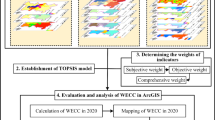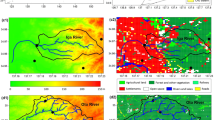Abstract
In order to improve water ecological service and ensure water resource protection, it is imperative to develop an effective evaluation method to identify the water-holding capacity of eco-environmental system. In this study, a comprehensive GIS-based data-fusion analysis framework is developed to evaluate the significance of water conservation/retention function (WCF), identify the potential effects of eco-environmental system on water-holding capability, and analyze the dynamic change of Songhua River basin for years 2000, 2005, 2010 and 2015. A general water conservation/retention function evaluation index is constructed associated with climate, geography and human factors to describe water conservation/retention function. Then, an exponential calculation method and regional integrated significance degree coefficient are used to calculate the WCF significance degrees and identify the distribution and change of WCF significance. The developed assessment framework is then applied in Songhua River basin for water ecological protection and environmental management. The results of WCF significance assessment indicate that only 0.56–2.97% of Songhua River basin is very important level of WCF ecological region with high water-holding capacity. The results of WCF significance assessment can help decision makers understand the temporal and spatial changes, identify priority areas for water resource protection, and provide a reasonable policy-guidance for mid- or long-term eco-environmental planning.




Similar content being viewed by others
Data Availability
Data, models, and codes generated or used for this study are available from the corresponding author on reasonable request.
References
Corrêa CJP, Tonello KC, Nnadi E (2021) Urban gardens and soil compaction: a land use alternative for runoff decrease. Environ Process. https://doi.org/10.1007/s40710-021-00521-3
Dong C, Huang G, Cheng GH, Zhao S (2018) Water resources and farmland management in the Songhua River Watershed under interval and fuzzy uncertainties. Water Resour Manage 32:4177–4200
Gebremeskel G, Gebremicael TG, Girmay A (2018) Economic and environmental rehabilitation through soil and water conservation, the case of Tigray in northern Ethiopia. J Arid Environ 151:113–124
Grizzetti B, Lanzanova D, Liquete C, Reynaud A, Cardoso AC (2016) Assessing water ecosystem services for water resource management. Environ Sci Policy 61:194–203
Hartanto H, Prabhu R, Ase W, Asdak C (2003) Factors affecting runoff and soil erosion: plot-level soil loss monitoring for assessing sustainability of forest management. For Ecol Manage 180(1):361–374
He L, Shen J, Zhang Y (2018) Ecological vulnerability assessment for ecological conservation and environmental management. J Environ Manag 206:1115–1125
Hu WM, Li G, Gao ZH, Jia GY, Wang ZC, Li Y (2020) Assessment of the impact of the Poplar Ecological Retreat Project on water conservation in the Dongting Lake wetland region using the InVEST model. Sci Total Environ 733:139423
Jia Y, Liu Y, Zhang SL (2021) Evaluation of agricultural ecosystem service value in arid and semiarid regions of northwest China based on the equivalent factor method. Environ Process 8:713–727
Jin T, Cai SB, Jiang DX, Liu J (2020) A data-driven model for real-time water quality prediction and early warning by an integration method. Environ Sci Pollut Res 26:30374–30385
Kang J, Jin R, Li X, Ma CF, Qin J, Zhang Y (2017) High spatio-temporal resolution mapping of soil moisture by integrating wireless sensor network observations and MODIS apparent thermal inertia in the Babao River Basin. China Remote Sens Environ 191:232–245
Li A, Wang A, Liang S, Zhou W (2006) Eco-environmental vulnerability evaluation in mountainous region using remote sensing and GIS—a case study in the upper reaches of Minjiang River. China Ecol Modell 192(1):175–187
Li L, Shi ZH, Yin W, Zhu D, Ng SL, Cai CF, Lei AL (2009) A fuzzy analytic hierarchy process (FAHP) approach to eco-environmental vulnerability assessment for the Danjiangkou reservoir area. China Ecol Modell 220(23):3439–3447
Lin C, Cheng H, Zhang C, Zhang Y, Wang LJ (2020) Using high-resolution remote sensing images to detect freshwater ecosystem changes—a new perspective of different ecosystem types and shapes. Water Resour Manag 34:3565–3584
Liu D, Cao CX, Dubovyk O, Tian R, Chen W, Zhuang QF, Zhao YJ, Menz G (2017) Using fuzzy analytic hierarchy process for spatio-temporal analysis of eco-environmental vulnerability change during 1990–2010 in Sanjiangyuan region, China. Ecol Indic 73:612–625
Melaku ND, Renschler CS, Flagler J, Bayu W, Klik A (2018) Integrated impact assessment of soil and water conservation structures on runoff and sediment yield through measurements and modeling in the Northern Ethiopian highlands. CATENA 169:140–150
Meng DJ, Mo XG (2012) Assessing the effect of climate change on mean annual runoff in the Songhua River basin, China. Hydrol Process 26:1050–1061
Meshram SG, Adhami M, Kisi O, Meshram C, Duc PA, Khedher KM (2021) Identification of critical watershed for soil conservation using Game Theory-Based approaches. Water Resour Manag 35:3105–3120
Miao CY, Yang L, Liu BY, Gao Y, Li SL (2011) Streamflow changes and its influencing factors in the mainstream of the Songhua River basin, Northeast China over the past 50 years. Environ Earth Sci 63:489–499
Ministry of Environmental Protection of the People’s Republic of China (MEP PRC) (2015) National key ecological function zone (Revision). http://www.mee.gov.cn/gkml/hbb/bgg/201511/t20151126_317777.htm. Accessed 23 Nov 2015
Mitchell M, Lockwood M, Moore SA, Clement S (2015) Scenario analysis for biodiversity conservation: a social-ecological system approach in the Australian Alps. J Environ Manag 150:69–80
Nguyen AK, Liou YA, Li MH, Tran TA (2016) Zoning eco-environmental vulnerability for environmental management and protection. Ecol Indic 69:100–117
Pacetti T, Castelli G, Bresci E, Caporali E (2020) Water values: participatory water ecosystem services assessment in the Arno River Basin, Italy. Water Resour Manag 34:4527–4544
Qu JH, Akindolie MS, Feng Y, Jiang Z, Zhang GS, Jiang Q, Deng FX, Cao B, Zhang Y (2020) One-pot hydrothermal synthesis of NaLa(CO3)(2) decorated magnetic biochar for efficient phosphate removal from water: Kinetics, isotherms, thermodynamics, mechanisms and reusability exploration. Chem Eng J 394:124915
Qu JH, Liu Y, Cheng L, Jiang Z, Zhang GS, Deng FX, Wang L, Han W, Zhang Y (2021) Green synthesis of hydrophilic activated carbon supported sulfide nZVI for enhanced Pb(II) scavenging from water: characterization, kinetics, isotherms and mechanisms. J Hazard Mater 403:123607
Qu JH, Meng QJ, Lin XF, Han W, Jiang Q, Wang L, Hu Q, Zhang L, Zhang Y (2021) Microwave-assisted synthesis of beta-cyclodextrin functionalized celluloses for enhanced removal of Pb(II) from water: adsorptive performance and mechanism exploration. Sci Total Environ 752:141854
Recanatesi F, Petroselli A (2020) Land cover change and flood risk in a peri-Urban environment of the Metropolitan Area of Rome (Italy). Water Resour Manag 34:4399–4413
Song XY, Song SB, Sun WY, Mu XM, Wang SY, Li JY, Li Y (2015) Recent changes in extreme precipitation and drought over the Songhua River Basin, China, during 1960–2013. Atmos Res 157:137–152
Teka D, Wesemael BV, Vanacker V, Poesen J, Hallet V, Taye G, Deckers J, Haregeweyn N (2013) Evaluating the performance of reservoirs in semi-arid catchments of Tigray: tradeoff between water harvesting and soil and water conservation. CATENA 110(2):146–154
Tolessa T, Gessese H, Tolera M, Kidane M (2018) Changes in ecosystem service values in response to changes in landscape composition in the central highlands of Ethiopia. Environ Process 5:483–501
Wang JT, Yun XJ, Su HT, Qing Y, Dong YP, Zhang DM (2008a) Technologies to monitor the rodent in the degraded grassland in “Three-River Headwaters” region. Pratacult Sci 25(8):110–112
Wang S, Zhang B, Wang S, Xie GD (2021) Dynamic changes in water conservation in the Beijing-Tianjin Sandstorm Source Control Project Area: a case study of Xilin Gol League in China. J Clean Prod 293:126054
Wang XD, Zhong XH, Liu SZ, Liu JG, Wang ZY, Li MH (2008b) Regional assessment of environmental vulnerability in the Tibetan Plateau: development and application of a new method. J Arid Environ 72(10):1929–1939
Wen Z, Zheng H, Smith JR, Ouyang ZY (2021) Plant functional diversity mediates indirect effects of land-use intensity on soil water conservation in the dry season of tropical areas. Forest Ecol Manag 480:118646
Wolka K, Mulder J, Biazin B (2018) Effects of soil and water conservation techniques on crop yield, runoff and soil loss in Sub-Saharan Africa: a review. Agric Water Res 207:67–79
Wu HB (2018) Watershed prioritization in the upper Han River basin for soil and water conservation in the South-to-North Water Transfer Project (middle route) of China. Environ Sci Pollut Res 25(3):2231–2238
Xue J, Gui DW, Lei JQ, Zeng FJ, Mao DL, Zhang ZW (2017) Model development of a participatory Bayesian network for coupling ecosystem services into integrated water resources management. J Hydrol 554:50–65
Zhai J, Liu YP, Hou P, Xiao T, Cao GZ (2016) Water conservation service assessment and its spatiotemporal features in national key ecological function zones. Adv Meteorol 6:1–11
Zhang B, Li WH, Xie GD, Xiao Y (2010) Water conservation of forest ecosystem in Beijing and its value. Ecol Econ 69(7):1416–1426
Zhang Y, Akindolie MS, Tian X, Wu B, Hu Q, Jiang Z, Wang L, Tao Y, Cao B, Qu JH (2021) Enhanced phosphate scavenging with effective recovery by magnetic porous biochar supported La(OH)3: kinetics, isotherms, mechanisms and applications for water and real wastewater. Bioresour Technol 319:124232
Zhou H, Huang JJ, Yuan YB (2017) Analysis of the spatial characteristics of the water usage patterns based on ESDA-GIS: an example of Hubei Province, China. Water Resour Manag 31:1503–1516
Acknowledgements
The authors are extremely grateful to the editors and anonymous reviewers for their insightful comments and suggestions.
Funding
This research was supported by Heilongjiang Postdoctoral Scientific Research Development Fund (Grant No. LBH-Q20068), Natural Science Foundation of Heilongjiang Province (Grant No.YQ2021E004), the National Natural Science Foundation of China (Grant No.52000022), and the National Natural Science Foundation of China (Grant No. 51809042).
Author information
Authors and Affiliations
Contributions
All authors contributed to the study conception, design and revisions. Conceptualization and coding: D.X. Jiang and Y.L. Chen; Methodology: D.X. Jiang, and Z.J. Qi; Formal analysis and investigation: D.X. Jiang and H. Zhu; Writing—original draft preparation: D.X. Jiang and J. Liu; Writing—review and editing: D.X. Jiang and Y.T. Guo; Supervision: J. Liu. All of the authors have read and agreed to the published version of the manuscript.
Corresponding authors
Ethics declarations
Conflict of interest
The authors declare that they have no conflicts of interest.
Consent to Participate
All authors have consent to participate in the study, and agreed to publish the manuscript.
Consent to Publish
All authors have consent and agreed to publish the manuscript and give the publisher the permission and rights to publish the work.
Ethical Approval
This study does not contain any studies with human participants or animals performed by any of the authors.
Additional information
Publisher's Note
Springer Nature remains neutral with regard to jurisdictional claims in published maps and institutional affiliations.
Supplementary Information
Below is the link to the electronic supplementary material.
Rights and permissions
About this article
Cite this article
Jiang, D., Guo, Y., Liu, J. et al. Spatiotemporal Assessment of Water Conservation Function for Ecosystem Service Management Using a GIS-Based Data-Fusion Analysis Framework. Water Resour Manage 35, 4309–4323 (2021). https://doi.org/10.1007/s11269-021-02949-6
Received:
Accepted:
Published:
Issue Date:
DOI: https://doi.org/10.1007/s11269-021-02949-6




